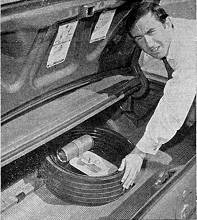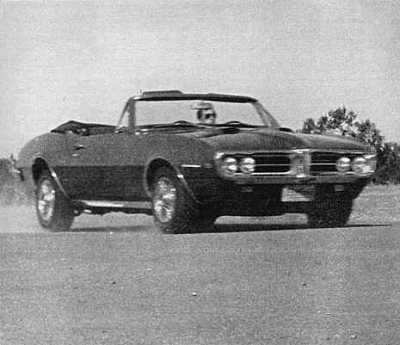
FOLD-UP TIRE THAT INFLATES WHEN NEEDED is Pontiac's unique solution for Firebird's "mini-trunk," which otherwise would be eaten up by spare tire
|
In acceleration trials I found the V8 Firebird a very good performance car. Despite a full tank of fuel and one passenger, I averaged 0-30 in two seconds, 0-60 in 7.4, 0-100 on 17.1.
The smaller Six wasn't nearly as quick, but it was running under handicaps that hardly allow a proper comparison—I had two passengers aboard and the carburetor was badly out of adjustment, causing the engine to run roughly at all speeds. In fact, during the cornering tests I made later on, I found that the fuel was cutting out completely. But, for what they are worth, here are the acceleration results with the Six: 0-30 in four seconds, 0-60 in 11.8, 0-100 in 35.
Both cars did quite well in a series of panic stops from 70 mph. On the first panic stop with the Six's manual brakes, the offside front brake at first appeared to be locking. But then it equalized itself, the kind of recovery that can be expected from disc brakes in that they improve as they heat up. Also, a characteristic of discs is quick recovery from brake fade. Required pedal pressure was not too heavy.
The brakes on the V8 gave me the impression I wasn't getting as much feel of the road as I'd like. My tests were made on dry pavement, yet I think it would be difficult to apply the power brakes on a panic basis under wet road conditions without locking the wheels. This is not a criticism of any one car, but of most American cars fitted with power-braking systems. Called for on such systems, I think, are antilocking devices.
 On the Six, I found the manual steering to be a bit heavy, which could be tiring in traffic. It may be that this condition is augmented by the big-footprint tires. On the other hand, the power-steering system on the V8 was too active, too insensitive, in my opinion, to road feel. On the Six, I found the manual steering to be a bit heavy, which could be tiring in traffic. It may be that this condition is augmented by the big-footprint tires. On the other hand, the power-steering system on the V8 was too active, too insensitive, in my opinion, to road feel.
Again, however, I personally think this applies to all U. S.-made cars with power steering. I believe power-assisted steering, rather than full power, would be more acceptable to most drivers. Power-assist provides easy maneuverability at low or parking speeds, but reduces its effect at higher speeds, providing a much better feel of the road. This system is used on large, heavy trucks and, I think, belongs on passenger cars as well.
Both cars handle quite well, affording neither oversteer nor understeer. I think a slight understeer is best for the average motorist in that it tends to warn him in time to slow down or even apply brakes when taking a turn. I found quite a bit of roll in both cars during high-speed cornering. Keep in mind, however, I was attempting to push the cars through the sharply angled corners as fast as I could; so fast, in fact, that at one point one of my passengers asked politely to be let out, thank you.
>> NEXT >>
|
| POPULAR MECHANICS |
FEBRUARY 1967 |
|